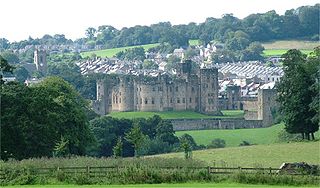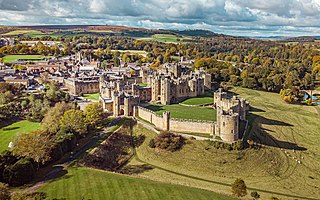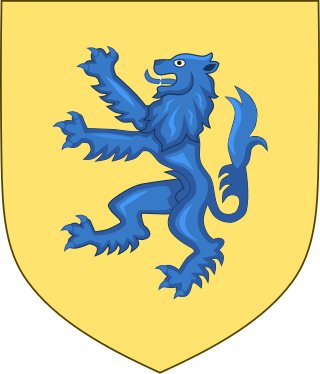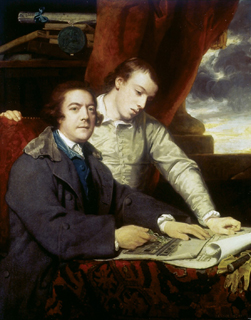
Stanwick Park (also known as Stanwick Hall) was a Palladian country house at Stanwick St John in North Yorkshire, England.

Stanwick Park (also known as Stanwick Hall) was a Palladian country house at Stanwick St John in North Yorkshire, England.
It was re-built by the 1st Duke of Northumberland, a great patron of the arts, c. 1739–1740, mostly to his own designs. The duke's principal seat was Alnwick Castle in Northumberland, thus Stanwick Park was always a secondary residence. The 1st Duke furnished the interior of the house with many works of art, including paintings by Canaletto. As a secondary seat, the house was often allocated to a dowager duchess of Northumberland. During the First World War, the house served as a military hospital. Following the end of the war, it remained empty. In 1918, on the death of 7th Duke of Northumberland, his heirs became liable for large death duties, and as a consequence in 1922 the 8th Duke of Northumberland sold the estate. [1] The house was demolished in 1923.
For many years, before the First World War, the house had been the residence of Eleanor Percy, Duchess of Northumberland. [2] The duchess lived at the house for 40 years until her death in 1911. She became so attached to the estate that she chose to be buried in the village church, which she had rebuilt by Salvin, rather than in the Northumberland vault in Westminster Abbey. [3] During her occupancy of the house, the gardens were expanded and developed, these included an Italian garden also designed by Salvin. During this period, the gardens were renowned for their glasshouses producing what at the time were considered rare and exotic fruits such as bananas, peaches, grapes, figs and nectarines; some varieties such as the "Stanwick nectarine" were propagated and bred on the estate. [4] The "Stanwick nectarine" was introduced to the United Kingdom by the diplomat John Barker. [5]
The interior of the house contained many fine 18th-century features; before the demolition, some of the decorations and motifs were removed. Three of the rooms were removed completely and are today believed by some to be those in the Minneapolis Institute of Arts. Comparisons with the extant photographs of the house interiors cast doubt upon this, and the links are doubtful; the director of the institute visited Alnwick in the 1930s to check on the provenance, but no record seems to exist of his ultimate findings. A firm called Robersons in London were in this relocation business. It seems possible that since there were 22 rooms from different houses being traded, of which only three were offered from Stanwick, there may have been an error. Museums in Roslyn, New York, and Toronto, as well as the collection of William Randolph Hearst are also alleged to have Stanwick rooms. [6]

Chatsworth House is a stately home in the Derbyshire Dales, 4 miles (6.4 km) north-east of Bakewell and 9 miles (14 km) west of Chesterfield, England. The seat of the Duke of Devonshire, it has belonged to the Cavendish family since 1549. It stands on the east bank of the River Derwent, across from hills between the Derwent and Wye valleys, amid parkland backed by wooded hills that rise to heather moorland. The house holds major collections of paintings, furniture, Old Master drawings, neoclassical sculptures and books. Chosen several times as Britain's favourite country house, it is a Grade I listed property from the 17th century, altered in the 18th and 19th centuries. In 2011–2012 it underwent a £14-million restoration. The owner is the Chatsworth House Trust, an independent charitable foundation formed in 1981, on behalf of the Cavendish family.

Alnwick is a market town in Northumberland, England, of which it is the traditional county town. The population at the 2011 Census was 8,116.

Alnwick Castle is a castle and country house in Alnwick in the English county of Northumberland. It is the seat of the 12th Duke of Northumberland, built following the Norman conquest and renovated and remodelled a number of times. It is a Grade I listed building now the home of Ralph Percy, 12th Duke of Northumberland and his family. In 2016, the castle received over 600,000 visitors per year when combined with adjacent attraction the Alnwick Garden.

Charles Seymour, 6th Duke of Somerset, known by the epithet "The Proud Duke", was an English aristocrat and courtier. He rebuilt Petworth House in Sussex, the ancient Percy seat inherited from his wife, in the palatial form which survives today. According to the Encyclopædia Britannica Eleventh Edition, he was a remarkably handsome man, and inordinately fond of taking a conspicuous part in court ceremonial; his vanity, which earned him the sobriquet of "the proud duke", was a byword among his contemporaries and was the subject of numerous anecdotes; Macaulay described him as "a man in whom the pride of birth and rank amounted almost to a disease".

Duke of Northumberland is a noble title that has been created three times in English and British history, twice in the Peerage of England and once in the Peerage of Great Britain. The current holder of this title is Ralph Percy, 12th Duke of Northumberland.

Kensington Palace is a royal residence set in Kensington Gardens, in the Royal Borough of Kensington and Chelsea in London, England. It has been a residence of the British royal family since the 17th century, and is currently the official London residence of the Prince and Princess of Wales, the Duke and Duchess of Gloucester, the Duke and Duchess of Kent, Prince and Princess Michael of Kent and Princess Eugenie and her husband Jack Brooksbank and their two sons.

Petworth House in the parish of Petworth, West Sussex, England, is a late 17th-century Grade I listed country house, rebuilt in 1688 by Charles Seymour, 6th Duke of Somerset, and altered in the 1870s to the design of the architect Anthony Salvin. It contains intricate wood-carvings by Grinling Gibbons. It is the manor house of the manor of Petworth. For centuries it was the southern home for the Percy family, earls of Northumberland.

The Percy family is an English noble family. They were among the most powerful noble families in Northern England for much of the Middle Ages. The noble family is known for its long rivalry with the House of Neville, another family powerful in northern England during the 15th century. The Percy-Neville feud provoked the War of the Roses, at the time known as the Civil Wars, in England.

Syon House is the west London residence of the Duke of Northumberland. A Grade I listed building, it lies within the 200-acre Syon Park, in the London Borough of Hounslow.

James Paine (1717–1789) was an English architect. He worked on number of country houses such as Chatsworth House, Thorndon Hall and Kedleston Hall.

Algernon George Percy, 6th Duke of Northumberland,, styled Lord Lovaine between 1830 and 1865 and Earl Percy between 1865 and 1867, was a British Conservative politician. He held office under the Earl of Derby as Paymaster General and Vice-President of the Board of Trade in 1859 and under Benjamin Disraeli as Lord Privy Seal between 1878 and 1880.

Stanwick St John is a village, civil parish, former manor and ecclesiastical parish in the Richmondshire district of North Yorkshire,, England. It is situated between the towns of Darlington and Richmond, close to Scotch Corner and the remains of the Roman fort and bridge at Piercebridge.

Hugh Percy, 1st Duke of Northumberland, was an English peer, politician, and landowner.

Devonshire House in Piccadilly, was the London townhouse of the Dukes of Devonshire during the 18th and 19th centuries. Following a fire in 1733 it was rebuilt by William Cavendish, 3rd Duke of Devonshire, in the Palladian style, to designs by William Kent. Completed circa 1740, it stood empty after the First World War and was demolished in 1924.

Keele Hall is a 19th-century mansion house at Keele, Staffordshire, England, now standing on the campus of Keele University and serving as the university conference centre. It is a Grade II* listed building.
Eleanor Percy, Duchess of Northumberland (1820–1911) was the wife of Algernon Percy, 4th Duke of Northumberland.

Alnwick Garden is a complex of formal gardens adjacent to Alnwick Castle in the town of Alnwick, Northumberland, England. The gardens have a long history under the dukes of Northumberland, but fell into disrepair until revived at the turn of the 21st century. The garden now features various themed plantings designed around a central water cascade. The revival of the gardens led to several public disputes between the Duchess of Northumberland and various garden experts concerning preservation and the use of public funds. The garden now belongs to a charitable trust, which is separate from Northumberland Estates, although the 12th Duke of Northumberland donated the 42-acre site and contributed £9 million towards redevelopment costs.

The destruction of country houses in 20th-century Britain was the result of a change in social conditions: many country houses of varying architectural merit were demolished by their owners. Collectively termed by several authors "the lost houses", the destruction of these now often-forgotten houses has been described as a cultural tragedy.

Isobel Jane Miller Percy, Duchess of Northumberland, is a British aristocrat and businesswoman. She has served as Lord Lieutenant of Northumberland since 2009, and is best known for redeveloping the Alnwick Garden at Alnwick Castle. She is the first woman to serve as Lord Lieutenant of Northumberland. Her husband, Ralph, is the 12th Duke of Northumberland.

Heath Hall, Heath, Wakefield, West Yorkshire is a country house dating from 1709. Originally called Eshald House, the estate was purchased by John Smyth whose nephew engaged John Carr of York to reconstruct the house between 1754 and 1780. In the 19th century, the house was remodelled by Anthony Salvin. Heath Hall is a Grade I listed building.